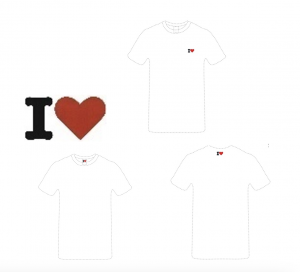
In May 2022, an EUTM application was filed regarding a position mark consisting of the letter “I” followed by the illustration of a red heart, located on the left side of a piece of clothing. The mark was filed for goods in class 25 in relation to clothing, particularly t-shirts, sweaters and sweatshirts.
However, the application was rejected by the examiner, and subsequently by the Board of Appeal, on the grounds that the characterization of the sign applied for as a positional mark did not allow to establish its distinctive character. The contested sign was perceived as a mere advertising message and it consisted in a sign of common use.
The applicant decided to appeal the decision before the General Court, arguing that it was an imaginative sign, as it was a complex graphic representation whose message required a certain degree of interpretation. Furthermore, the appellant considers that the EUIPO had examined the contested mark on the basis of the figurative mark criteria, when the contested sign is a positional mark. In this sense, the applicant argues that the position of the mark has not been taken into account in order to assess the distinctiveness of the mark. It also points out the relevance of the position of the marks in the textile industry , since it is a common practice that signs placed on the chest are perceived as a trademark by the general public.
However, the EUIPO argues that the sign “I” followed by the illustration of a red heart does not have distinctiveness by itself since it is perceived as a laudatory expression that expresses affinity or preference for the designated goods, for this reason it would be interpreted by consumers as a promotional message. Likewise, the sign applied for lacks originality since it is a sign whose use is common in the market and therefore it can’t be associated with a specific commercial origin.
The General Court agrees with the EUIPO that a sign lacking distinctiveness cannot acquire distinctiveness by the mere position in which it is located. In order to determine the distinctiveness of a position mark, its appearance must be taken into account, and in the present case the contested sign did not stand out in relation to the designated goods. Moreover, the placement on the left chest area of a garment has no relevant impact on the shape of the garment. As the sign has a laudatory meaning, it will not be perceived by the public as a trademark, even though its position is in line with the labeling practices of the sector. It should be noted that non-distinctive signs or advertising slogans can also be placed in the area indicated by the applicant, therefore the contested sign cannot acquire distinctiveness due to the position in which it is placed.
In conclusion, the contested sign does not have an inherent distinctiveness because its meaning has a promotional connotation and it is a sign that, due to its popularity, lacks originality. Therefore it won’t be possible to distinguish the designated goods from those of other undertakings. Likewise, the position of the sign cannot confer such distinctiveness. Consequently, the Court dismisses the appeal.
The same conclusion and legal reasoning is found in decisions T-305/24 and T-306/24 concerning the same sign in different positions.
Decision of the General Court in case T-304/24 – July 9 2025.


 Español
Español Deutsch
Deutsch